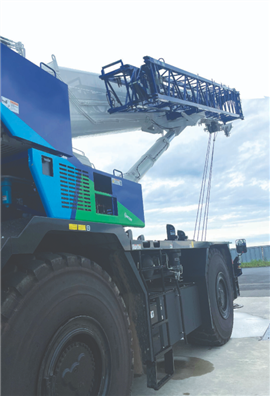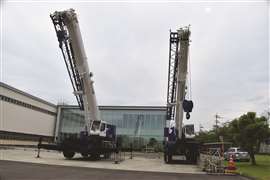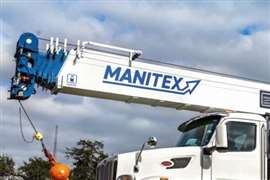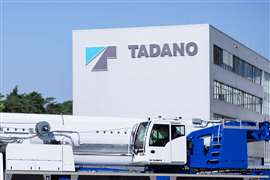Tadano’s first electric rough terrain crane for North America
22 September 2024
Power Progress’ sister publication American Cranes & Transport (ACT) visited the Shido, Japan, manufacturing plant for lifting equipment OEM Tadano in early July. There, the company’s product development team presented and demonstrated the Tadano EVOLT eGR-1000XLL-1 rough terrain crane. The new battery-electric crane was in the middle of final testing before being made available to the North American market.
 Tadano’s new 100-ton capacity battery operated EVOLT eGR-1000XLL-1 is set for North American distribution. (Photo: KHL Staff)
Tadano’s new 100-ton capacity battery operated EVOLT eGR-1000XLL-1 is set for North American distribution. (Photo: KHL Staff)
“We are very confident in the investment we’ve made in this crane,” said Dean Barley, president and CEO at Tadano America of the 100-ton-capacity machine. “This crane has been tested and retested. We wanted to make sure that the first fully electric rough terrain (RT) crane in North America meets all the requirements of the market.”
Barley added, “It was important to make sure this crane could operate in severe conditions, in heat and in frigid areas like Canada, where our RTs are very popular.”
Significant Noise Reduction
The product demonstration put the new EVOLT alongside a Tadano GR-1000XLL-4 diesel-powered crane for comparison. ACT reported the only difference in the operation of the two cranes was the EVOLT’s silent operation. Additionally, the only discernible noise was when the boom hydraulics were engaged.
“Aside from the EVOLT operating silently, these cranes are virtually the same except for their power source,” Barley said. “And of course, the EVOLT is emissions-free.”
Barley added that Tadano expects the EVOLT’s quiet operation to be a major selling point for nighttime operations near hospitals and residential areas.
The EVOLT’s six lithium ion battery packs provide 226 kWh of electric power. The crane is designed for battery electric (BE) lifting operation of five hours coupled with 5.5 miles (9 km) of jobsite travel distance. If performing lifting operations alone, the machine can operate for as many as seven hours before traveling back to its charging station.
 At the Shido Plant in Japan, a diesel-powered Tadano GR-1000XLL-4 and the new electric EVOLT eGR-1000XLL-1 were demonstrated side by side. The only difference in the operation of the two cranes is that the EVOLT is emissions-free and it operates silently. (Photo: KHL Staff)
At the Shido Plant in Japan, a diesel-powered Tadano GR-1000XLL-4 and the new electric EVOLT eGR-1000XLL-1 were demonstrated side by side. The only difference in the operation of the two cranes is that the EVOLT is emissions-free and it operates silently. (Photo: KHL Staff)
The EVOLT uses electric motors for the driveline as well as to power the crane’s hydraulic pumps. The electric motor is a Dana TM4 LSM200C AC synchronous motor. Two variable piston pumps drive the crane functions, while a tandem gear pump is for steering, slewing and other hydraulic systems.
The EVOLT offers two charging options. The Type CCS1 DC fast charging system has a maximum power output of 150 kW. It can recharge the crane in about two hours. For normal AC charging, there is a 480 V AC three-phase system that requires 4.5 to 5.5 hours at 40 kW. With normal use, the batteries will likely last eight to ten years.
The EVOLT can also operate on grid power, if necessary.
Operational and Emissions Benefits
As the EVOLT will cost a bit more than its diesel counterpart, Tadano said it paid close attention to cost of operation. Barley said that operational savings will be able to make up for the machine’s additional cost, as the company estimates that the EVOLT will reduce operating costs on an annual basis by about 35 percent versus a diesel-powered crane. This estimate was based on fuel and electricity as well as maintenance costs at 1,200 operating hours per year.
As part of Tadano’s Green Solutions initiative, the company has already produced an electric crane for the Japanese market. The Tadano EVOLT eGR-250N-1, which the company called the world’s first fully electric RT crane, has been on the Japanese market since 2023.
“Beyond the annual operations cost savings, the EVOLT reduces carbon emissions by 49,000 lb.,” Barley said.
According to Tadano President and CEO Toshiaki Ujiie, advancing decarbonization and “green solutions” is an important initiative for the company.
“We have decarbonization goals for 2030 and to 2050,” he said. “We have an aggressive plan to produce electric and hybrid product lines. We will continue to give our customers green choices.”
STAY CONNECTED



Receive the information you need when you need it through our world-leading magazines, newsletters and daily briefings.
CONNECT WITH THE TEAM








